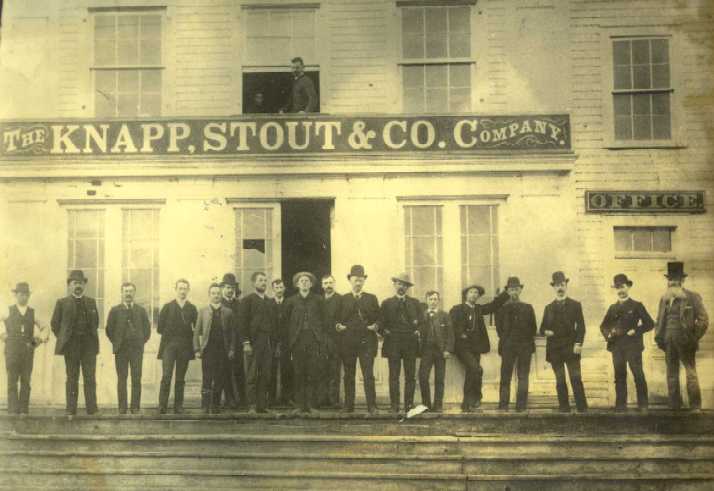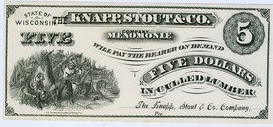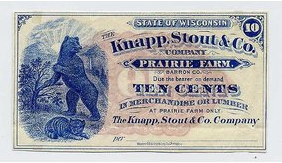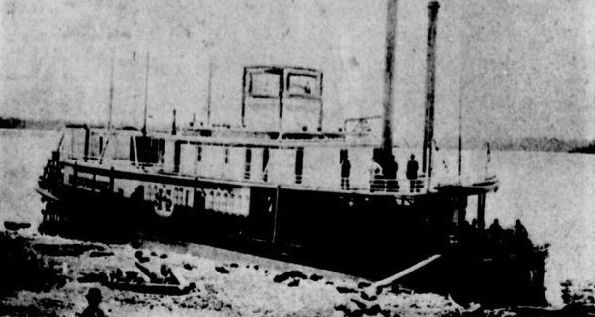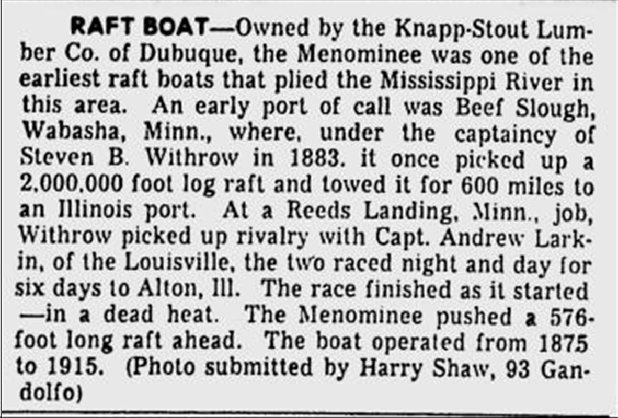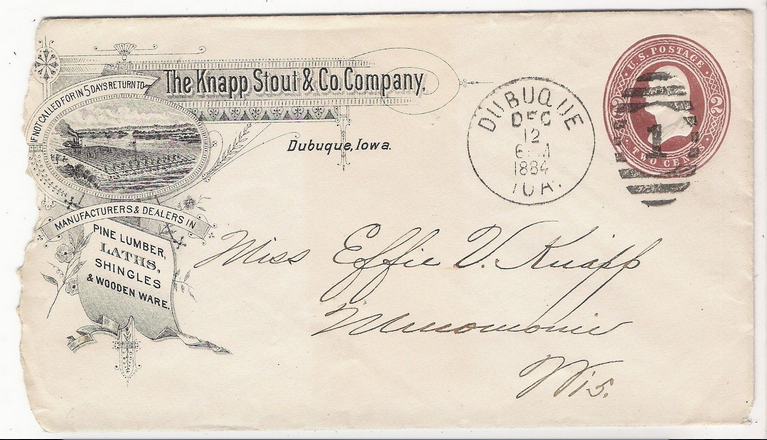Encyclopedia Dubuque
"Encyclopedia Dubuque is the online authority for all things Dubuque, written by the people who know the city best.”
Marshall Cohen—researcher and producer, CNN
Affiliated with the Local History Network of the State Historical Society of Iowa, and the Iowa Museum Association.
KNAPP, STOUT AND COMPANY: Difference between revisions
No edit summary |
No edit summary |
||
| (12 intermediate revisions by the same user not shown) | |||
| Line 1: | Line 1: | ||
[[Image:ksoffice.jpg|left|thumb|350px|Photo courtesy: University of Wisconsin, Stout]] | |||
[[Image:ks1.jpg|left|thumb|350px|Made by engravers in Chicago to resemble U.S. money, Knapp, Stout "currency" were used in company-owned stores.]] | [[Image:ks1.jpg|left|thumb|350px|Made by engravers in Chicago to resemble U.S. money, Knapp, Stout "currency" were used in company-owned stores.]] | ||
[[Image:kscurrency21.png|left|thumb|350px|Note the form of payment.]] | [[Image:kscurrency21.png|left|thumb|350px|Note the form of payment.]] | ||
[[Image:kstoken11.png|left|thumb|250px|Good for lumber or merchandise]] | [[Image:kstoken11.png|left|thumb|250px|Good for lumber or merchandise]] | ||
KNAPP, STOUT AND COMPANY. | KNAPP, STOUT AND COMPANY. On June 1, 1846 John H. Knapp, Sr., William Wilson, a Mr. Green and David Black took over the operation of a sawmill on Wilson Creek in Wisconsin. The mill, renamed Knapp & Black, had been constructed in 1831 and was considered the oldest mill in the state. In 1854 Andrew Tainter entered the business which was then renamed the [[KNAPP-TAINTER LUMBER COMPANY]]. [[STOUT, Henry L.|Henry L. STOUT]] purchased an interest in the business in 1850 and the company was renamed Knapp, Stout & Company. (1) The firm experienced a rapid expansion between 1866 and 1869 with three mills opened in Wisconsin. (2) | ||
The mill at Menomonie eventually became the company's largest warehouse. Employing seven hundred workers in 1866, the Menomonie mill became the company headquarters in 1886 and employed two thousand workers by 1898. ( | The mill at Menomonie eventually became the company's largest warehouse. Employing seven hundred workers in 1866, the Menomonie mill became the company headquarters in 1886 and employed two thousand workers by 1898. (3) In Dubuque, lumberyards belonging to the company stretched over twenty acres and employed an estimated one hundred fifty men. | ||
In 1869 the company made its first expansion into shipping by purchasing the steamboat" Anna Girdon" to transport cut timber. This allowed the company to make considerable savings which it reinvested in more land and equipment improvements which helped it survive tough competition in the [[LUMBER INDUSTRY]]. ( | In 1869 the company made its first expansion into shipping by purchasing the steamboat" Anna Girdon" to transport cut timber. This allowed the company to make considerable savings which it reinvested in more land and equipment improvements which helped it survive tough competition in the [[LUMBER INDUSTRY]]. (4) In 1877 the company ran out 40 rafts of logs each averaging 1,500,000 feet of lumber. (5) Between 1871 and 1881 the company's shipping fleet expanded to eight ships. (6) | ||
By 1878 when it was incorporated at Knapp, Stout and Company, the firm was considered the largest manufacturer of lumber in the United States and was thought to be the largest lumber corporation in the world. ( | By 1878 when it was incorporated at Knapp, Stout and Company, the firm was considered the largest manufacturer of lumber in the United States and was thought to be the largest lumber corporation in the world. (7) | ||
By 1881 the company had branch offices in Dubuque, Downsville, Waubeck, Reed's Landing and St. Louis. There were small mills at Rice Lake and Prairie Farm. ( | By 1881 the company had branch offices in Dubuque, Downsville, Waubeck, Reed's Landing and St. Louis. There were small mills at Rice Lake and Prairie Farm. (8) In 1882 a merger with the Red Cedar Improvement and Log Driving Company increased the capital stock of the company. (9) In 1887 between 1,200 to 1,500 men were employed in the timber forests, mills and yards of the company. The average pay roll was $2,000 daily. (10) | ||
The company at its peak employed 3,000 men. When a worker became too old for the more demanding efforts, they were kept on staff and assigned to lighter work. (11) | |||
In 1901, the company (using the same name) was incorporated by C. W. Chapman and [[STOUT, Frank D.|Frank D. STOUT]] with a capitalization of $100,000. ( | On July 14, 1891 it was announced that the company had been sold to an English syndicate. [[STOUT, Frank D.|Frank D. STOUT]] and [[STOUT, James Huff|James Huff STOUT]] among others remained as managers. The announcement included the fact that the company "was easily" valued at $10,790,416.00 and had averaged $997,471.70 in income over the past three years. The new company would be named Knapp, Stout Lumber Company. (12) | ||
Between 1875 and 1915, the company owned and operated the "Menominee," one of the earliest raft boats on the Upper Mississippi. It once towed a log raft containing an estimated 2 million feet of lumber for 600 miles. (13) | |||
On January 6, 1890 Knapp-Stout sold its seventh street mill in Dubuque to two of its former salesmen, C. J. Lesure and J. J. Van Villet. (14) This mill was developed into the [[LESURE LUMBER COMPANY]]. (15) | |||
[[Image:menu.jpg|left|thumb|350px|The menu at the 50th anniversary of the company. Photo courtesy: www.uwstout.edu/lib/archives/photoarch.cfm ]]In January 1893 officials announced that the company would construct a planing mill at the corner of Eighth and Washington [[STREETS]]. Planing had been done at [[FARLEY AND LOETSCHER MANUFACTURING COMPANY]]. (16) A disastrous fire in June 1894, led to the loss of approximately fourteen million feet of lumber. The liquidation of the company timber lands in Wisconsin led to the November 1900 announcement that the Dubuque branch would be closed. (17) The company intended on centralizing itself in St. Louis. This site, however, was sold in 1903 for one million dollars. (18) | |||
In 1901, the company (using the same name) was incorporated by C. W. Chapman and [[STOUT, Frank D.|Frank D. STOUT]] with a capitalization of $100,000. (19) In 1908 the company was sold to [[SPAHN AND ROSE LUMBER COMPANY]]. (20) | |||
The 1861 through 1890-91 ''Dubuque City Directory'' stated that this business was to be found at the northeast corner of 8th and Washington. | The 1861 through 1890-91 ''Dubuque City Directory'' stated that this business was to be found at the northeast corner of 8th and Washington. | ||
| Line 20: | Line 29: | ||
[[Image:rboat.jpg|left|thumb|350px|]] | [[Image:rboat.jpg|left|thumb|350px|]] | ||
[[Image:RAFTBOAT.jpg|left|thumb|350px|Telegraph Herald Oct. 9, 1960. Image courtesy: Diane Harris]] | [[Image:RAFTBOAT.jpg|left|thumb|350px|Telegraph Herald Oct. 9, 1960. Image courtesy: Diane Harris]] | ||
[[Image:knappenvelope.png|right|thumb|350px|]] | |||
--- | --- | ||
Source: | Source: | ||
1. | 1. "Old Firm Quits," ''Dubuque Daily Telegraph'', August 7, 1901, p. 2 | ||
2. "Golden Jubilee," ''Dubuque Daily Herald'', August 16, 1896, p. 8 | |||
3. Hudson, David; Bergman, Marvin; Horton, Loren. '''The Biographical Dictionary of Iowa'''. Iowa City: The University of Iowa Press, 2008. p. 497 | |||
4. Knapp-Stout & Co. Company Photo Archive. Online: | |||
http://www.uwstout.edu/lib/archives/photoarch.cfm | http://www.uwstout.edu/lib/archives/photoarch.cfm | ||
5. "Caught on the Fly," ''Dubuque Herald'', October 26, 1877, p. 4. Online: https://news.google.com/newspapers?nid=uh8FjILnQOkC&dat=18771026&printsec=frontpage&hl=en | |||
5. | |||
6. | 6. Hudson, p. 496 | ||
7. | 7. Holand, H. R. "The Knapp-Stout & Co. Lumber Company." '''The Wisconsin Magazine of History''', Vol. 3, No. 4, Jun., 1920. p. 470 Online: http://www.jstor.org/stable/4630265 | ||
8. | 8. Kerker, Renae. "The Sage of the Sawdust: The Life of Henry L. Stout," Unpublished thesis, December 1, 1979, p. 3 | ||
9. | 9. Kerker, p. 4 | ||
10. | 10. '''The Industries of Dubuque: Her Relations as a Trade Center,''' Dubuque: J. M. Elster and Company, Publishers, 1887, p. 63 | ||
11. | 11. "Old Firm Quits..." | ||
12. | 12. "Fine Finish by Flanders," ''Dubuque Daily Herald'', July 14, 1891, p. 4. Online: https://news.google.com/newspapers?nid=_OG5zn83XeQC&dat=18910714&printsec=frontpage&hl=en | ||
13. | 13. "Way Back When," Telegraph Herald, October 14, 1960. | ||
14. Kerker, p. 4 | |||
15. Ibid. | |||
16. "Municipal Molecules," ''Dubuque Daily Herald'', January 5, 1893, p. 4 | |||
17. Kerker, p. 5 | |||
18. Ibid. | |||
19. Ibid. | |||
20. Ibid. | |||
[[Category: Lumber Company]] | [[Category: Lumber Company]] | ||
Latest revision as of 02:10, 7 April 2018
KNAPP, STOUT AND COMPANY. On June 1, 1846 John H. Knapp, Sr., William Wilson, a Mr. Green and David Black took over the operation of a sawmill on Wilson Creek in Wisconsin. The mill, renamed Knapp & Black, had been constructed in 1831 and was considered the oldest mill in the state. In 1854 Andrew Tainter entered the business which was then renamed the KNAPP-TAINTER LUMBER COMPANY. Henry L. STOUT purchased an interest in the business in 1850 and the company was renamed Knapp, Stout & Company. (1) The firm experienced a rapid expansion between 1866 and 1869 with three mills opened in Wisconsin. (2)
The mill at Menomonie eventually became the company's largest warehouse. Employing seven hundred workers in 1866, the Menomonie mill became the company headquarters in 1886 and employed two thousand workers by 1898. (3) In Dubuque, lumberyards belonging to the company stretched over twenty acres and employed an estimated one hundred fifty men.
In 1869 the company made its first expansion into shipping by purchasing the steamboat" Anna Girdon" to transport cut timber. This allowed the company to make considerable savings which it reinvested in more land and equipment improvements which helped it survive tough competition in the LUMBER INDUSTRY. (4) In 1877 the company ran out 40 rafts of logs each averaging 1,500,000 feet of lumber. (5) Between 1871 and 1881 the company's shipping fleet expanded to eight ships. (6)
By 1878 when it was incorporated at Knapp, Stout and Company, the firm was considered the largest manufacturer of lumber in the United States and was thought to be the largest lumber corporation in the world. (7)
By 1881 the company had branch offices in Dubuque, Downsville, Waubeck, Reed's Landing and St. Louis. There were small mills at Rice Lake and Prairie Farm. (8) In 1882 a merger with the Red Cedar Improvement and Log Driving Company increased the capital stock of the company. (9) In 1887 between 1,200 to 1,500 men were employed in the timber forests, mills and yards of the company. The average pay roll was $2,000 daily. (10)
The company at its peak employed 3,000 men. When a worker became too old for the more demanding efforts, they were kept on staff and assigned to lighter work. (11)
On July 14, 1891 it was announced that the company had been sold to an English syndicate. Frank D. STOUT and James Huff STOUT among others remained as managers. The announcement included the fact that the company "was easily" valued at $10,790,416.00 and had averaged $997,471.70 in income over the past three years. The new company would be named Knapp, Stout Lumber Company. (12)
Between 1875 and 1915, the company owned and operated the "Menominee," one of the earliest raft boats on the Upper Mississippi. It once towed a log raft containing an estimated 2 million feet of lumber for 600 miles. (13)
On January 6, 1890 Knapp-Stout sold its seventh street mill in Dubuque to two of its former salesmen, C. J. Lesure and J. J. Van Villet. (14) This mill was developed into the LESURE LUMBER COMPANY. (15)
In January 1893 officials announced that the company would construct a planing mill at the corner of Eighth and Washington STREETS. Planing had been done at FARLEY AND LOETSCHER MANUFACTURING COMPANY. (16) A disastrous fire in June 1894, led to the loss of approximately fourteen million feet of lumber. The liquidation of the company timber lands in Wisconsin led to the November 1900 announcement that the Dubuque branch would be closed. (17) The company intended on centralizing itself in St. Louis. This site, however, was sold in 1903 for one million dollars. (18)
In 1901, the company (using the same name) was incorporated by C. W. Chapman and Frank D. STOUT with a capitalization of $100,000. (19) In 1908 the company was sold to SPAHN AND ROSE LUMBER COMPANY. (20)
The 1861 through 1890-91 Dubuque City Directory stated that this business was to be found at the northeast corner of 8th and Washington.
---
Source:
1. "Old Firm Quits," Dubuque Daily Telegraph, August 7, 1901, p. 2
2. "Golden Jubilee," Dubuque Daily Herald, August 16, 1896, p. 8
3. Hudson, David; Bergman, Marvin; Horton, Loren. The Biographical Dictionary of Iowa. Iowa City: The University of Iowa Press, 2008. p. 497
4. Knapp-Stout & Co. Company Photo Archive. Online: http://www.uwstout.edu/lib/archives/photoarch.cfm
5. "Caught on the Fly," Dubuque Herald, October 26, 1877, p. 4. Online: https://news.google.com/newspapers?nid=uh8FjILnQOkC&dat=18771026&printsec=frontpage&hl=en
6. Hudson, p. 496
7. Holand, H. R. "The Knapp-Stout & Co. Lumber Company." The Wisconsin Magazine of History, Vol. 3, No. 4, Jun., 1920. p. 470 Online: http://www.jstor.org/stable/4630265
8. Kerker, Renae. "The Sage of the Sawdust: The Life of Henry L. Stout," Unpublished thesis, December 1, 1979, p. 3
9. Kerker, p. 4
10. The Industries of Dubuque: Her Relations as a Trade Center, Dubuque: J. M. Elster and Company, Publishers, 1887, p. 63
11. "Old Firm Quits..."
12. "Fine Finish by Flanders," Dubuque Daily Herald, July 14, 1891, p. 4. Online: https://news.google.com/newspapers?nid=_OG5zn83XeQC&dat=18910714&printsec=frontpage&hl=en
13. "Way Back When," Telegraph Herald, October 14, 1960.
14. Kerker, p. 4
15. Ibid.
16. "Municipal Molecules," Dubuque Daily Herald, January 5, 1893, p. 4
17. Kerker, p. 5
18. Ibid.
19. Ibid.
20. Ibid.


